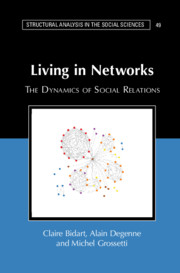Book contents
- Living in Networks
- Structural Analysis in the Social Sciences
- Living in Networks
- Copyright page
- Contents
- Figures
- Tables
- Preface
- Acknowledgments
- Introduction
- Part I Foundations of a Sociology of Relational Dynamics
- 1 Understanding Relationships
- 2 Analyzing Networks
- Part II Networks and Their Dynamics
- Part III Networks and Social Worlds
- Conclusion
- References
- Index
- Structural Analysis in the Social Sciences
2 - Analyzing Networks
from Part I - Foundations of a Sociology of Relational Dynamics
Published online by Cambridge University Press: 27 October 2020
- Living in Networks
- Structural Analysis in the Social Sciences
- Living in Networks
- Copyright page
- Contents
- Figures
- Tables
- Preface
- Acknowledgments
- Introduction
- Part I Foundations of a Sociology of Relational Dynamics
- 1 Understanding Relationships
- 2 Analyzing Networks
- Part II Networks and Their Dynamics
- Part III Networks and Social Worlds
- Conclusion
- References
- Index
- Structural Analysis in the Social Sciences
Summary
Various characteristics of the networks are examined: their composition, density, homogeneity and dispersion. Their overall structure can be very varied, and therefore builds contrasting environments. Using examples, various personal network profiles are described by analysing the social issues that lie beneath their differences. The study of personal networks, their distribution, their temporal strata, their diversity, and their degree of interconnection, therefore allows us to approach a kind of dynamic social mapping of the modes of circulation and anchoring in social worlds. To better grasp the particularities of personal network analysis, the authors briefly explore a few examples.
- Type
- Chapter
- Information
- Living in NetworksThe Dynamics of Social Relations, pp. 49 - 72Publisher: Cambridge University PressPrint publication year: 2020

